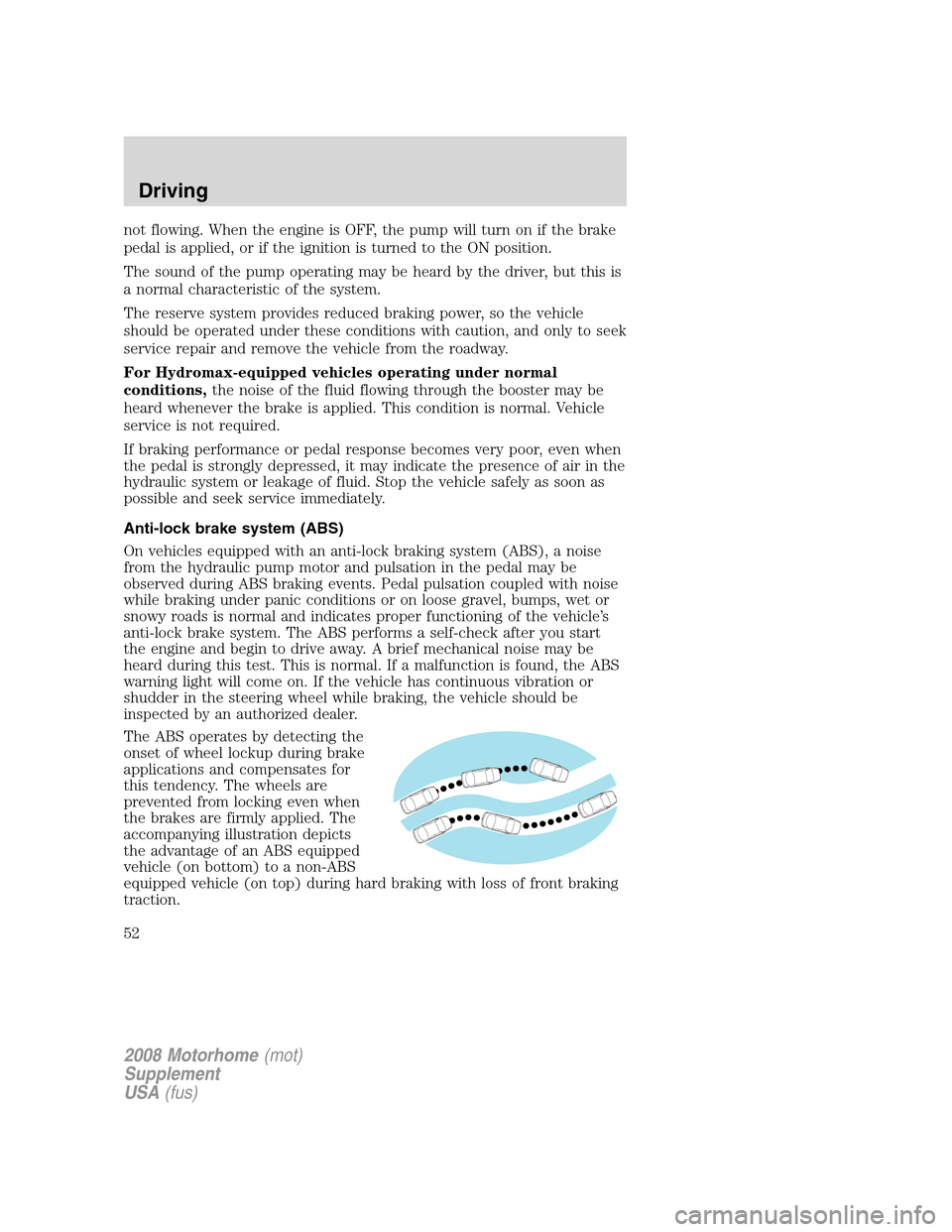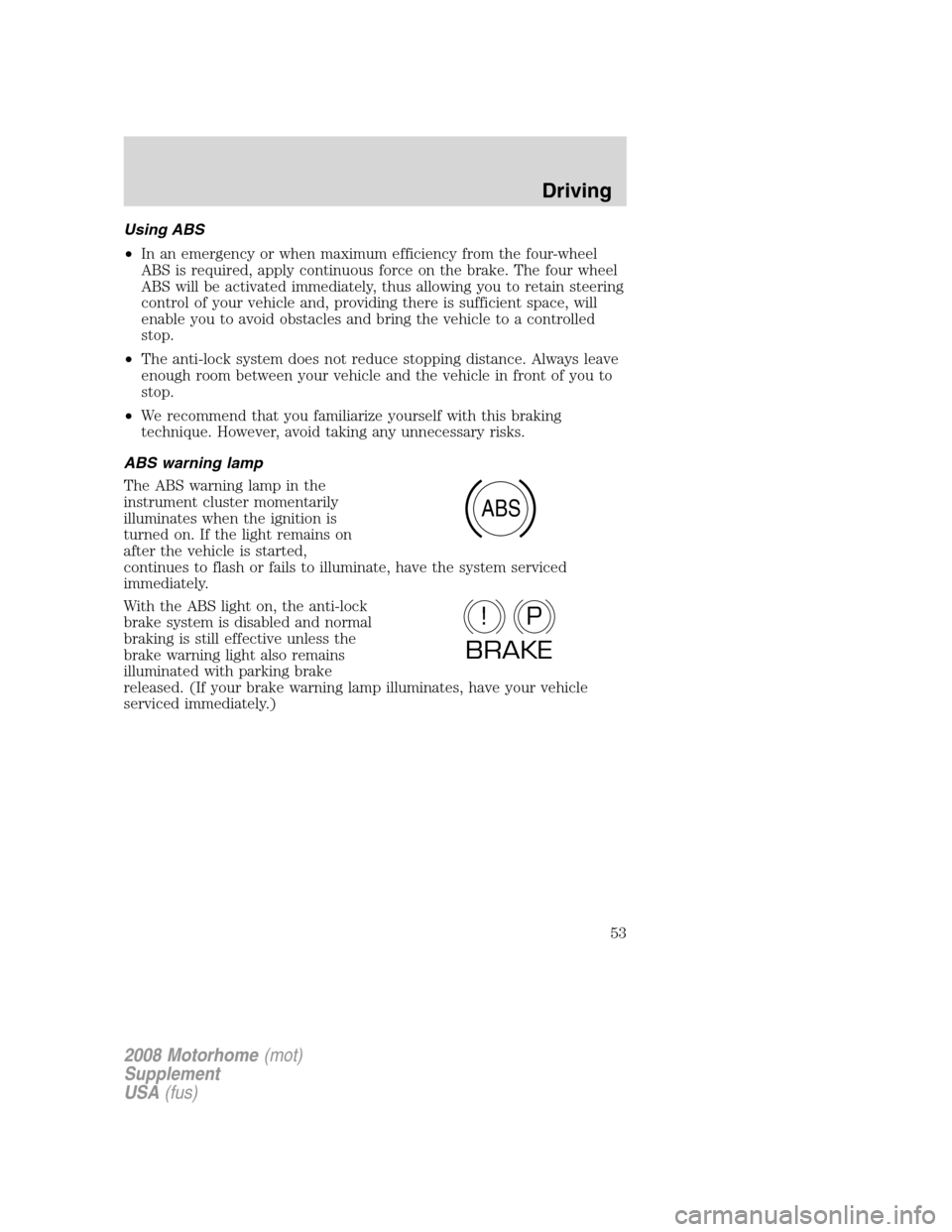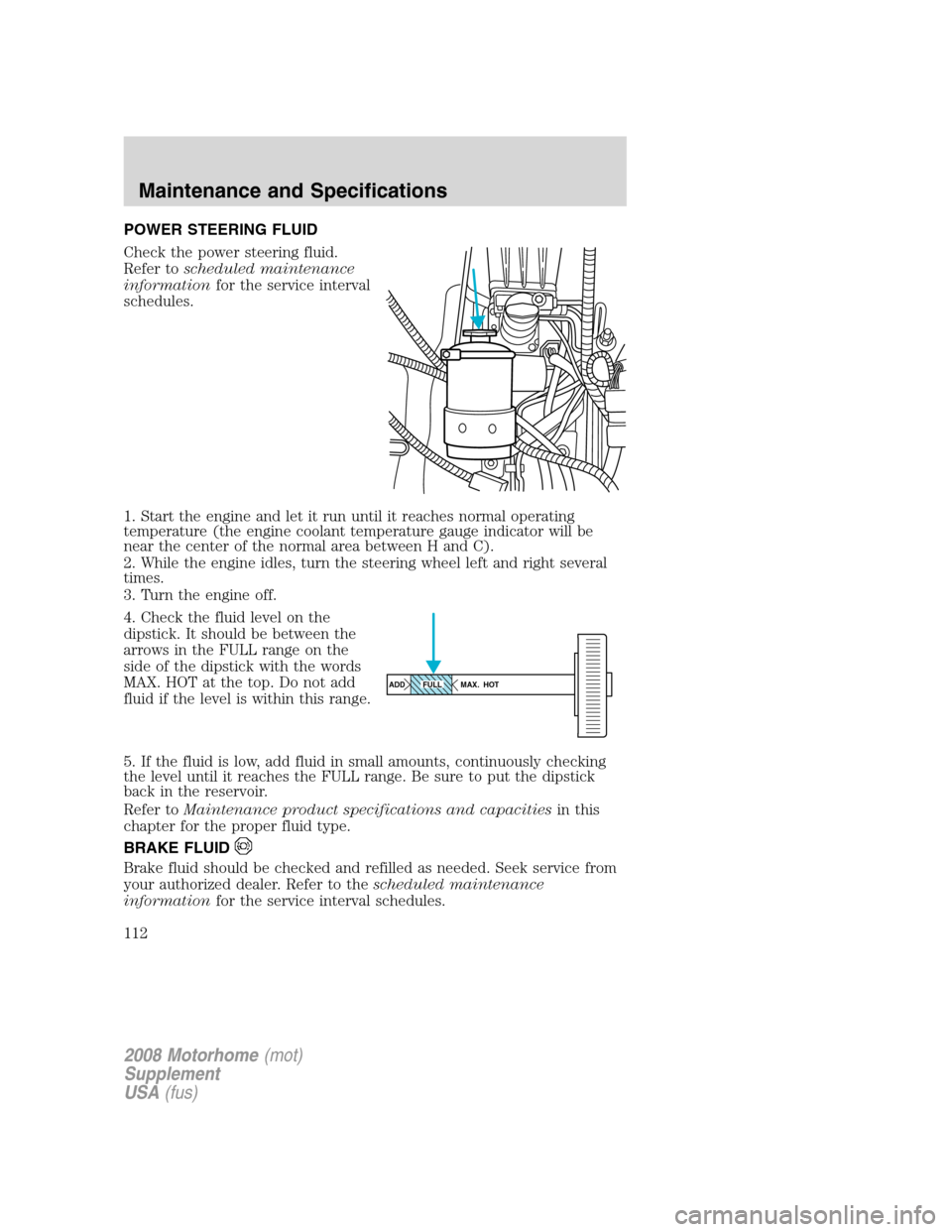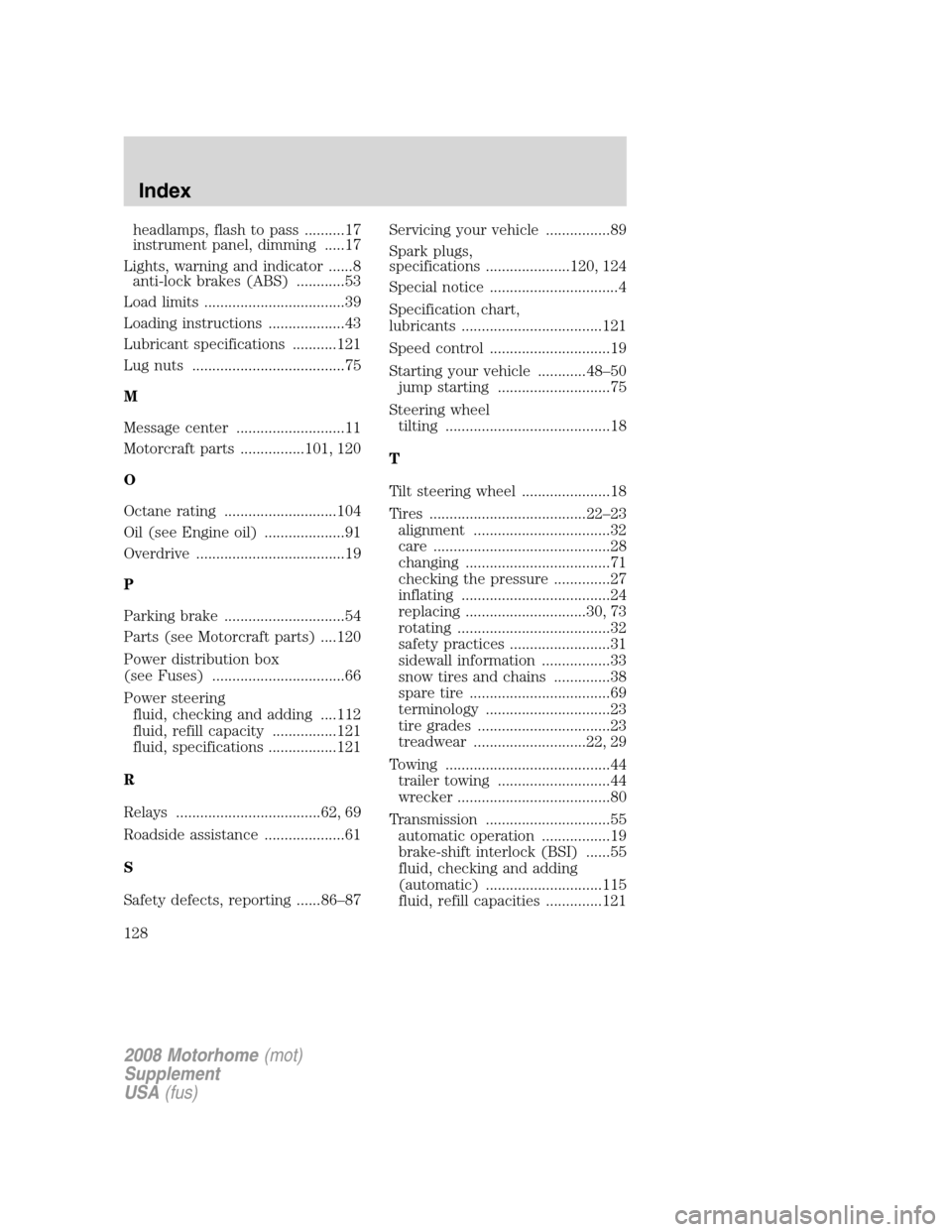Page 52 of 130

not flowing. When the engine is OFF, the pump will turn on if the brake
pedal is applied, or if the ignition is turned to the ON position.
The sound of the pump operating may be heard by the driver, but this is
a normal characteristic of the system.
The reserve system provides reduced braking power, so the vehicle
should be operated under these conditions with caution, and only to seek
service repair and remove the vehicle from the roadway.
For Hydromax-equipped vehicles operating under normal
conditions,the noise of the fluid flowing through the booster may be
heard whenever the brake is applied. This condition is normal. Vehicle
service is not required.
If braking performance or pedal response becomes very poor, even when
the pedal is strongly depressed, it may indicate the presence of air in the
hydraulic system or leakage of fluid. Stop the vehicle safely as soon as
possible and seek service immediately.
Anti-lock brake system (ABS)
On vehicles equipped with an anti-lock braking system (ABS), a noise
from the hydraulic pump motor and pulsation in the pedal may be
observed during ABS braking events. Pedal pulsation coupled with noise
while braking under panic conditions or on loose gravel, bumps, wet or
snowy roads is normal and indicates proper functioning of the vehicle’s
anti-lock brake system. The ABS performs a self-check after you start
the engine and begin to drive away. A brief mechanical noise may be
heard during this test. This is normal. If a malfunction is found, the ABS
warning light will come on. If the vehicle has continuous vibration or
shudder in the steering wheel while braking, the vehicle should be
inspected by an authorized dealer.
The ABS operates by detecting the
onset of wheel lockup during brake
applications and compensates for
this tendency. The wheels are
prevented from locking even when
the brakes are firmly applied. The
accompanying illustration depicts
the advantage of an ABS equipped
vehicle (on bottom) to a non-ABS
equipped vehicle (on top) during hard braking with loss of front braking
traction.
2008 Motorhome(mot)
Supplement
USA(fus)
Driving
52
Page 53 of 130

Using ABS
•In an emergency or when maximum efficiency from the four-wheel
ABS is required, apply continuous force on the brake. The four wheel
ABS will be activated immediately, thus allowing you to retain steering
control of your vehicle and, providing there is sufficient space, will
enable you to avoid obstacles and bring the vehicle to a controlled
stop.
•The anti-lock system does not reduce stopping distance. Always leave
enough room between your vehicle and the vehicle in front of you to
stop.
•We recommend that you familiarize yourself with this braking
technique. However, avoid taking any unnecessary risks.
ABS warning lamp
The ABS warning lamp in the
instrument cluster momentarily
illuminates when the ignition is
turned on. If the light remains on
after the vehicle is started,
continues to flash or fails to illuminate, have the system serviced
immediately.
With the ABS light on, the anti-lock
brake system is disabled and normal
braking is still effective unless the
brake warning light also remains
illuminated with parking brake
released. (If your brake warning lamp illuminates, have your vehicle
serviced immediately.)
ABS
P!
BRAKE
2008 Motorhome(mot)
Supplement
USA(fus)
Driving
53
Page 62 of 130
•The hazard flasher control is
located on top of the steering
column.
•Depress hazard lights control to
activate the hazard flashers.
•Depress control again to turn the
flashers off.
FUSES AND RELAYS
Standard fuse amperage rating and color
COLOR
Fuse
ratingMini
fusesStandard
fusesMaxi
fusesCartridge
maxi
fusesFuse link
cartridge
2A Grey Grey — — —
3A Violet Violet — — —
4A Pink Pink — — —
5A Tan Tan — — —
7.5A Brown Brown — — —
10A Red Red — — —
15A Blue Blue — — —
20A Yellow Yellow Yellow Blue Blue
25A Natural Natural — — —
30A Green Green Green Pink Pink
40A — — Orange Green Green
50A — — Red Red Red
60A — — Blue Yellow Yellow
70A — — Tan — Brown
80A — — Natural Black Black
Passenger compartment fuse panel
The fuse panel is located below and to the left of the steering wheel by
the brake pedal. Remove the panel cover to access the fuses.
2008 Motorhome(mot)
Supplement
USA(fus)
Roadside Emergencies
62
Page 69 of 130
Diode/Relay module
The module box is located by the power distribution box in front of the
radiator in the engine compartment.
The components are coded as follows:
Relay location Description
1 One touch integrated start (ATO diode)
2 Not used
3 Not used
4 DRL power (relay)
5 Reverse lamps (relay)
6 Trailer tow parking lamps (relay)
7 Not used
8 Starter ground (relay)
CHANGING A FLAT TIRE
If you get a flat tire while driving:
•do not brake heavily.
•gradually decrease the vehicle’s speed.
•hold the steering wheel firmly.
•slowly move to a safe place on the side of the road.
Dissimilar spare tire/wheel information
WARNING:Failure to follow these guidelines could result in an
increased risk of loss of vehicle control, injury or death.
If you have a dissimilar spare tire/wheel, then it is intended for
temporary use only. This means that if you need to use it, you should
2008 Motorhome(mot)
Supplement
USA(fus)
Roadside Emergencies
69
Page 112 of 130

POWER STEERING FLUID
Check the power steering fluid.
Refer toscheduled maintenance
informationfor the service interval
schedules.
1. Start the engine and let it run until it reaches normal operating
temperature (the engine coolant temperature gauge indicator will be
near the center of the normal area between H and C).
2. While the engine idles, turn the steering wheel left and right several
times.
3. Turn the engine off.
4. Check the fluid level on the
dipstick. It should be between the
arrows in the FULL range on the
side of the dipstick with the words
MAX. HOT at the top. Do not add
fluid if the level is within this range.
5. If the fluid is low, add fluid in small amounts, continuously checking
the level until it reaches the FULL range. Be sure to put the dipstick
back in the reservoir.
Refer toMaintenance product specifications and capacitiesin this
chapter for the proper fluid type.
BRAKE FLUID
Brake fluid should be checked and refilled as needed. Seek service from
your authorized dealer. Refer to thescheduled maintenance
informationfor the service interval schedules.
ADD MAX. HOTFULL
2008 Motorhome(mot)
Supplement
USA(fus)
Maintenance and Specifications
112
Page 128 of 130

headlamps, flash to pass ..........17
instrument panel, dimming .....17
Lights, warning and indicator ......8
anti-lock brakes (ABS) ............53
Load limits ...................................39
Loading instructions ...................43
Lubricant specifications ...........121
Lug nuts ......................................75
M
Message center ...........................11
Motorcraft parts ................101, 120
O
Octane rating ............................104
Oil (see Engine oil) ....................91
Overdrive .....................................19
P
Parking brake ..............................54
Parts (see Motorcraft parts) ....120
Power distribution box
(see Fuses) .................................66
Power steering
fluid, checking and adding ....112
fluid, refill capacity ................121
fluid, specifications .................121
R
Relays ....................................62, 69
Roadside assistance ....................61
S
Safety defects, reporting ......86–87Servicing your vehicle ................89
Spark plugs,
specifications .....................120, 124
Special notice ................................4
Specification chart,
lubricants ...................................121
Speed control ..............................19
Starting your vehicle ............48–50
jump starting ............................75
Steering wheel
tilting .........................................18
T
Tilt steering wheel ......................18
Tires .......................................22–23
alignment ..................................32
care ............................................28
changing ....................................71
checking the pressure ..............27
inflating .....................................24
replacing ..............................30, 73
rotating ......................................32
safety practices .........................31
sidewall information .................33
snow tires and chains ..............38
spare tire ...................................69
terminology ...............................23
tire grades .................................23
treadwear ............................22, 29
Towing .........................................44
trailer towing ............................44
wrecker ......................................80
Transmission ...............................55
automatic operation .................19
brake-shift interlock (BSI) ......55
fluid, checking and adding
(automatic) .............................115
fluid, refill capacities ..............121
2008 Motorhome(mot)
Supplement
USA(fus)
Index
128